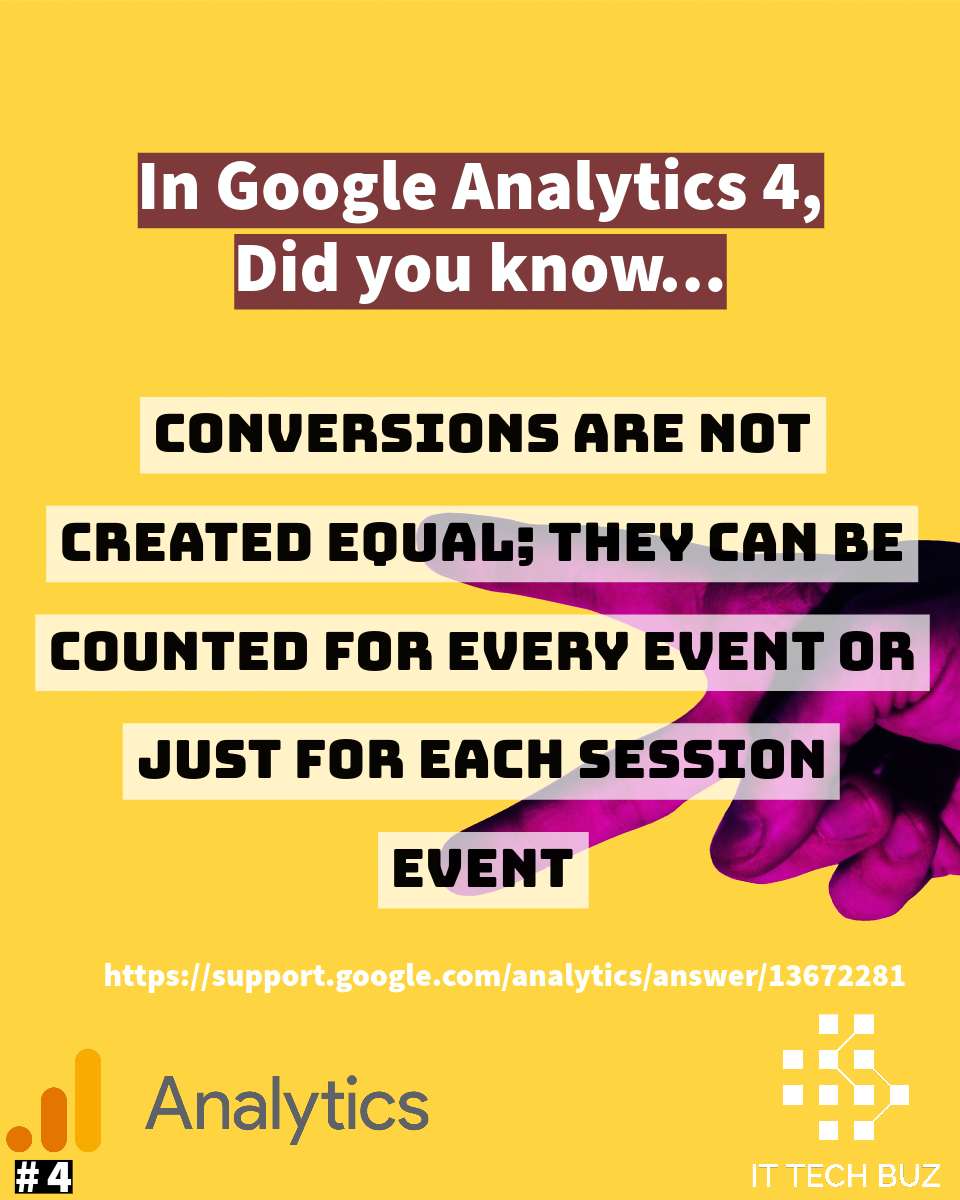Table of Contents
Google Analytics 4 (GA4) introduced a more flexible and user-centric way of measuring user interactions compared to Universal Analytics (UA). One of the significant changes was in the way conversions (or what were previously known as “goals” in UA) are defined and tracked
Here’s a detailed explanation of conversions in Google Analytics 4:
What are Conversions in GA4?
In GA4, conversions refer to any valuable user actions on your website or app. These can be anything from a user making a purchase, signing up for a newsletter, downloading an ebook, or any other action that’s valuable to your business.
“Conversions can be counted for each time they happen or only one time for each session like on Universal Analytics.”
How to Set Up Conversions in GA4:
In GA4, any event can be marked as a conversion. This is different from UA, where only specific goals could be defined as conversions.
To set up a conversion:
- Go to your GA4 property.
- Click on “Events” under the “Configure” section.
- Locate the event you want to mark as a conversion and click on it.
- Toggle the “Mark as conversion” switch.
- Your event is now tracked as a conversion.
Conversions Reporting:
You can find data on your conversions in various parts of the GA4 interface.
The “Life Cycle” reports will show conversion data in the context of the user journey, from acquisition to engagement and finally to conversion.
The “User” reports help you understand more about the audience converting on your site.
The “Events” reports show detailed data about the conversion events you’ve marked.
Comparing Conversions Across Segments:
One of the powerful features in GA4 is the ability to quickly compare conversions across user segments. You can create segments based on various parameters and then see how different groups of users convert.
Value-driven Conversions:
In GA4, you can assign a monetary value to your conversions. This helps you quantify the impact of conversions on your business. It’s especially useful when analyzing return on ad spend or the overall value of your traffic.
Flexibility with Conversion Attribution:
GA4 introduces a more flexible approach to attribution. It allows for more sophisticated attribution models that can account for multiple touchpoints in a user’s conversion journey, unlike UA’s last-click model.
Source:
https://support.google.com/analytics/answer/13672281
Need training ?
People like you are reading:
- ROAS vs ROI: Why your business should care?
 For years, Return on Ad Spend (ROAS) has been the dominant metric for evaluating digital advertising success. It is simple, accessible, and provides a quick measure of campaign efficiency. However, this simplicity is deceptive. ROAS is a vanity metric that offers a dangerously incomplete picture of performance, often masking critical issues like poor profit margins and unsustainable growth strategies. While 63.3% of marketers feel pressure from their CFO to prove the value of marketing, relying on ROAS alone fails to speak the language of business outcomes: profitability.
For years, Return on Ad Spend (ROAS) has been the dominant metric for evaluating digital advertising success. It is simple, accessible, and provides a quick measure of campaign efficiency. However, this simplicity is deceptive. ROAS is a vanity metric that offers a dangerously incomplete picture of performance, often masking critical issues like poor profit margins and unsustainable growth strategies. While 63.3% of marketers feel pressure from their CFO to prove the value of marketing, relying on ROAS alone fails to speak the language of business outcomes: profitability. - High Season peaks with Google Analytics 4
 Prepare High Season peaks with Google Analytics 4 (GA4) The high season for sales represents the most significant revenue opportunity of the year, but for many organisations, it is a period of reactive, high-stress decision-making. A failure to prepare the digital analytics infrastructure inevitably leads to misallocated budgets, lost conversion opportunities, and an inability to demonstrate financial impact to leadership.
Prepare High Season peaks with Google Analytics 4 (GA4) The high season for sales represents the most significant revenue opportunity of the year, but for many organisations, it is a period of reactive, high-stress decision-making. A failure to prepare the digital analytics infrastructure inevitably leads to misallocated budgets, lost conversion opportunities, and an inability to demonstrate financial impact to leadership. - Conversational AI with Google Analytics 4
 Conversational AI to get timely Insights? Analyse Your Google Analytics 4 (GA4) Traffic Patterns with Context. Executive Summary In today’s data-saturated landscape, the critical challenge for leadership is not the…
Conversational AI to get timely Insights? Analyse Your Google Analytics 4 (GA4) Traffic Patterns with Context. Executive Summary In today’s data-saturated landscape, the critical challenge for leadership is not the… - AI in Marketing Analytics
 Explore the pros and cons of using AI in Marketing Analytics Executive Summary Artificial intelligence (AI) has become an essential tool for digital marketing analytics, offering significant advantages for businesses…
Explore the pros and cons of using AI in Marketing Analytics Executive Summary Artificial intelligence (AI) has become an essential tool for digital marketing analytics, offering significant advantages for businesses… - Small and Big Data Value in Marketing
 Small and Big Data In 2025, marketing leaders are under mounting pressure to prove ROI, with 64% citing “demonstrating the impact of marketing actions on financial outcomes” as their top…
Small and Big Data In 2025, marketing leaders are under mounting pressure to prove ROI, with 64% citing “demonstrating the impact of marketing actions on financial outcomes” as their top…
This post is also available in:
![]() Português (Portuguese (Portugal))
Português (Portuguese (Portugal)) ![]() Español (Spanish)
Español (Spanish)





